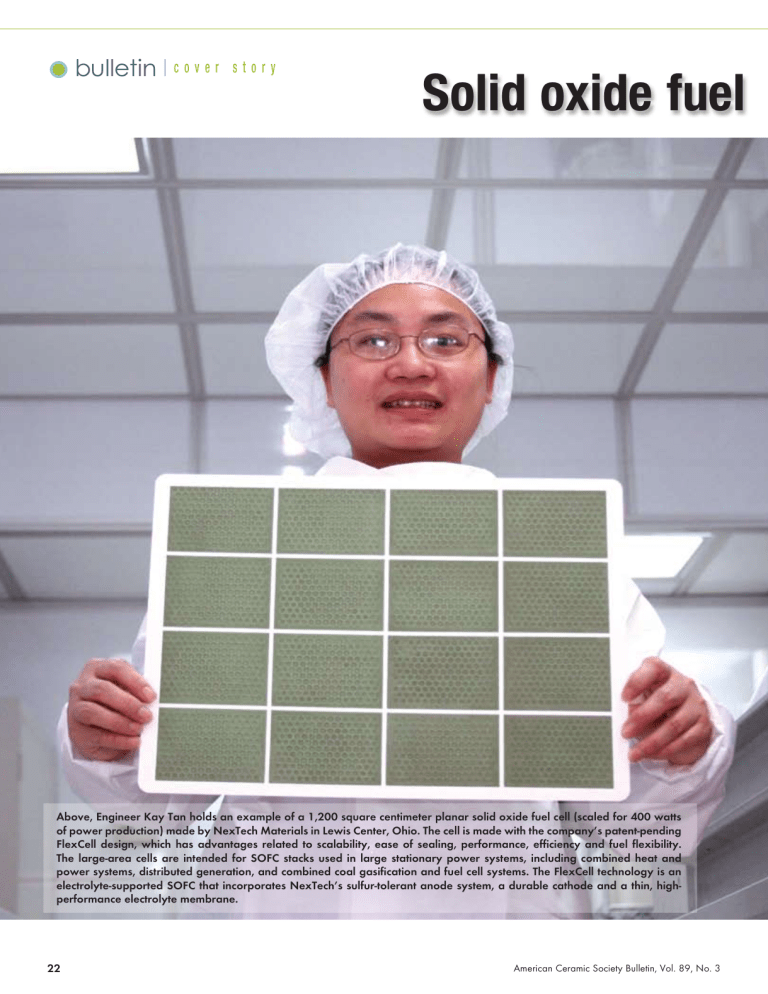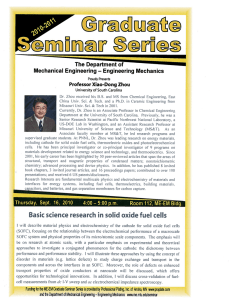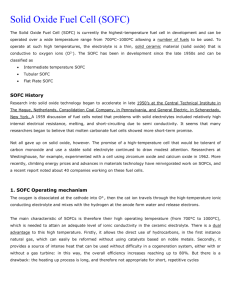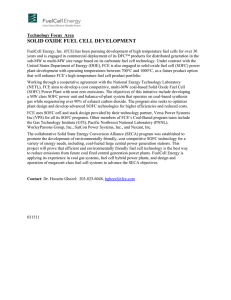Solid Oxide Fuel Cell Commercialization, Research and Challenges

bulletin
c o v e r s t o r y
Solid oxide fuel cell commercialization, research and challenges
22
Above, Engineer Kay Tan holds an example of a 1,200 square centimeter planar solid oxide fuel cell (scaled for 400 watts of power production) made by NexTech Materials in Lewis Center, Ohio. The cell is made with the company’s patent-pending
FlexCell design, which has advantages related to scalability, ease of sealing, performance, efficiency and fuel flexibility.
The large-area cells are intended for SOFC stacks used in large stationary power systems, including combined heat and power systems, distributed generation, and combined coal gasification and fuel cell systems. The FlexCell technology is an electrolyte-supported SOFC that incorporates NexTech’s sulfur-tolerant anode system, a durable cathode and a thin, highperformance electrolyte membrane.
American Ceramic Society Bulletin, Vol. 89, No. 3
Solid oxide fuel cell commercialization, research and challenges
by Eric D. Wachsman and Subhash C. Singhal
Introduction
The benefits of solid oxide fuel cells are unabiguous: SOFCs are efficient energy producers that emit smaller amounts of CO
2
then most currently available hydrocarbon-fueled sources. Equally important, they can be adapted to a variety of fuels and might be the missing link to “clean” coal energy production.
According to the Department of Energy, the technical roots of SOFCs reach back at least 70 years. Over the decades, companies from Westinghouse to
General Electric to even Consolidated Coal have attempted to bring SOFCs to the utility, commercial and residential markets – with limited success. More recently, dozens of others companies ranging from giants, such as Siemens,
United Technologies, Delphi, Rolls-Royce and Honda, to startups, such as Ceres
Power and FuelCell Energy – not to mention intermediate materials suppliers, such as NexTech Materials, CeramTec and Fuel Cell Materials – have joined the race to develop cost-competitive SOFC applications.
Indeed, a series of technical obstacles to SOFC practicality have fallen in recent years, and large- and small-scale products have begun to be offered. But,
SOFCs have a reputation for being finicky divas in the energy world, and progress in pricing and performance has remained incremental. Significant market penetration seemingly always is “just a decade away.”
Thus, many eyebrows were raised in the technical and business communities in late February when a little-known company, Bloom Energy (see page
25), suddenly announced with much fanfare that it had succeeded in developing a commercial, patented 100-kilowatt SOFC product. It turned out that these
Bloom Energy Servers (also known as Bloom “Boxes”) began to be installed in mid-2008 to customers that include Bank of America, Coca-Cola, Google and
FedEx. CBS’s Sixty Minutes also featured the company in an exclusive profile.
By the time Bloom Energy held its public unveiling, its suite of installed SOFCs had collectively produced an impressive 11 million kilowatt-hours of electricity.
As a result, publicity about SOFCs and the role of ceramic materials in them has never been greater. The hope that SOFCs will be a major part of the world’s energy-production portfolio has grown proportionally.
Yet, much is still to be known about the technology used in Bloom’s SOFCs and about the company’s financial arrangements with its customers. Skeptics abound.
Given these developments, we present this report – prepared just a few months before Bloom Energy’s announcement – from two ACerS members, Eric
D. Wachsman and Subhash C. Singhal – that surveys the technical SOFC landscape and suggests where the scientific hurdles remain.
– Peter Wray
W
orldwide interest in solid oxide fuel cells has increased dramatically during the past 20 years as indicated, in part, by the tremendous growth in attendance at the
International Symposium on
Solid Oxide Fuel Cells.
When the symposium began in 1989, the proceedings of the meeting were only around
60 pages long. In comparison, the proceedings from the most recent symposium – 2009 – now run to nearly 1,000 pages in length.
In the United States, the Department of
Energy’s Office of Fossil Energy’s National
Energy Technology Laboratory, in partnership with private industry, educational institutions and national laboratories, is leading the research, development and demonstration of high-efficiency, fuel-flexible SOFCs and coalbased SOFC power generation systems for stationary market large central-power plants.
1
This fuel cell program has three focus areas under the Solid State Energy Conversion
Alliance (see page 28): cost reduction, coalbased systems and research and development.
The SECA cost-reduction goal is to have
SOFC stacks capable of being manufactured at $170 per kilowatt (2007 basis) by 2010.
Concurrently, the scale up, aggregation
This article was originally prepared for the Electrochemical Society. It appeared in the Fall 2009 edition of Interface and is used with permission.
American Ceramic Society Bulletin, Vol. 89, No. 3 23
Solid oxide fuel cell these systems using SOFCs produced by Kyocera Inc. The systems operate on natural gas and provide an electric conversion efficiency of about 45– s50 percent.
Similar CHP systems are also being produced and field tested in Australia,
New Zealand and Europe by Ceramic
Fuel Cells Ltd. of Australia. The
Japanese and the Australian CHP systems use SOFCs based on the conventional yttria-stabilized zirconia electrolyte and operate at about 750°–800°C.
On the other hand, Ceres Power Ltd. of the United Kingdom is developing
SOFCs of about 1-kilowatt size based on a ceria-based electrolyte for operation at
550°–600°C for use in wall-mountable residential CHP systems.
Fig. 1. SOFC-based residential combined heat and power system showing the
SOFC unit (left) and the hot water tank (right). and integration of the technology will progress in parallel, leading to prototype validation of megawatt-class fuel-flexible products by 2015. The
SECA coal-based systems goal is the development of large (greater than 100 megawatt) integrated gasification fuel cell power systems. Under this program, in February 2009, two fuel cell stacks
(around 10 kilowatts each), developed by FuelCell Energy Inc. in partnership with Versa Power Systems, achieved
5,000 hours of service. The stacks also exhibited an overall degradation of only
1.7 percent and 2.6 percent per 1,000 hours. A Siemens’ stack also surpassed
5,000 hours in April 2009. Another
SECA industry team, Delphi and the
Navy, have made noteworthy development progress in early markets for truck auxiliary power units and proof-of-concept for unmanned undersea vehicles.
Combined heat and power units
Using tubular (cylindrical) SOFCs,
Siemens has also fabricated a 100-kilowatt system for distributed power generation.
2,3 This system has now operated for more than four years in the United
States, Netherlands, Germany and Italy with no detectable performance degradation. It has provided up to 108-kilowatt of alternating-current electricity at an efficiency of 46 percent. Siemens tubular cells also have been used to fabricate and field test more than a dozen 5-kilowattsized combined heat and power units, each about the size of a refrigerator.
These CHP units gave excellent performance and performance stability on a variety of hydrocarbon fuels. However, at present, their cost is high. Future such units are expected to use higher power density alternate tubular geometry cells to drive down the cost.
Several hundred 1-kilowatt-sized
CHP units for residential applications were field tested by Sulzer Hexis of
Switzerland. However, their cost and performance degradation was high and stack lifetime too short.
With improved sealing materials and sealing concepts, planar SOFC prototype systems in the 1 kilowatt to 5 kilowatt sizes have recently been developed. Significant progress now has been made in producing and field testing about 1-kilowatt sized SOFC-based
CHP systems for residential applications. In Japan, more than 50 such prototype systems have been installed in homes to provide electricity and hot water, and are collecting performance data for commercialization that is planned in about a year.
A photograph of one such unit is shown in Fig. 1. Tokyo Gas, Osaka Gas and Eneos in Japan have constructed
Polymer electrolyte membrane cells
Another application of SOFC systems is in the transportation sector, although the polymer electrolyte membrane fuel cell has been generally regarded as the fuel cell of choice for transportation applications. PEM fuel cells require pure H
2
, with no CO, as the fuel to operate successfully.
However, presently, no H tems to produce H
2
2
infrastructure exists, and on-board reformer sys-
from existing fuel base (gasoline, diesel) are technically challenging, complex and expensive.
Furthermore, it is difficult to eliminate the CO entirely from the reformate stream. In contrast, SOFCs can use CO along with H
2
as fuel, and their higher operating temperature and availability of water on the anode side make on-cell or in-stack reformation of hydrocarbon fuels feasible. Also, no noble metal catalysts are used in SOFCs, reducing cost of the cells.
SOFCs for transportation
The initial SOFC entry point into the transportation sector will be for on board auxiliary power units. Such
APUs, operating on an existing fuel base, will supply the ever increasing electrical power demands of luxury automobiles, recreational vehicles and heavy-duty trucks. Delphi Corp. has continued on page 26
24 American Ceramic Society Bulletin, Vol. 89, No. 3
A Bloom Box server arriving for installation.
▼ Bloom’s fuel cell plates.
Bloom bursts into
SOFC business
by Peter Wray
For months, all that people knew about Bloom Energy was that the company was working in the field of solid oxide fuel cells and had received the financial backing of the legendary techoriented venture capital firm Kleiner
Perkings Caulfield & Byers. A few clues about the Silicon Valley company however were around: Founder K.R.
Srindhar coauthored several papers in the Journal of the American Ceramic
Society and other technical publications on ceramic substrate strength and techniques to generate oxygen on Mars using solid oxide electrolysis. He had granted one generic interview about his fuel cell plans to Fresh Dialogues, a business, technology and arts website.
Enigmatically, for months the firm’s webpage contained only a clock that counted down to Feb. 24, 2010, signaling a major event was to occur. Just days before the event, publicists for the
Sixty Minutes television show spread word that they would air a sneak peak of Bloom “Box” fuel cells that might be
“an energy breakthrough.”
The Sixty Minutes’ story revealed that Bloom had developed and manufactured 100-kilowatt SOFC stacks that had already been in successful operation at big named firms, such as Bank of America, eBay and Google. In fact,
Bloom demonstrated that its SOFC units that could be easily “plugged in” to a company’s power network after being set in place with a forklift.
Srindhar bragged that his design avoided the use of expensive catalysts, such as platinum, and he displayed his solution that consisted of two square, white panels, one imprinted with a green
“ink,” and the other with black.
The Feb. 24 event turned out to be a made-for-primetime-media affair, hosted at eBay’s headquarters, featuring
California Gov. Arnold Schwarzenegger and former Secretary of State Colin
Powell (the latter a member of Bloom’s board of directors).
So, has Bloom succeeded where others have failed? The answer seems to depend on how one defines “success.”
In the accompanying article by
Wachsman and Singhal, the authors discuss efforts to build durable anodesupported SOFCs that could operate at a lower temperature. Wachsman doesn’t believe that Bloom had succeeded in unveiling a “new” SOFC and is using basic fuel cell technology, i.e., not the more-promising anode supported variety. He could not see any obvious solution by Bloom to the problem of over 900°C temperatures.
Wachsman was unimpressed with avoidance of platinum, noting that the panels Sridhar showed off likely had a substrate of yttria-stabilized zirconia.
The inks, he wrote, were probably
NiO-YSZ (green) serving as the anode and lanthanum strontium manganite
(black) working as the cathode layer.
As for the uniqueness of these materials, Wachsman noted that several companies already provided these inks to other SOFC companies and researchers.
What about the problems
Wachsman and Singhal discuss regarding thermal expansion differences in
SOFC materials and the heat stress that weakens substrates, interconnects and stack seals? Sridhar makes two remarkable, if not novel, claims about these issues. In an interview with
GreenTechMedia, the Bloom chief says his SOFCs use special metal plates that have the same thermal expansion as the ceramics used, thereby eliminating the aforementioned problems.
He further adds that Bloom turns the high temperature into an asset.
Although the company boasts of not needing an external fuel reforming system for its units, he doesn’t directly address whether the SOFC boxes contain an internal reformer that employs the heat to prepare the fuel cell inputs
– a feat that would allow a variety of fossil fuels to be used.
Bloom’s weakest argument is cost.
Each 100-kilowatt unit “costs” around
$700,000, but that includes a special
California tax break and federal tax incentives. In other words, the subsidized cost is $7,000 per kilowatt, a price still far from the $400 per kilowatt price
SECA estimates (see pages 28–29) is needed to reach commercialization. For the time being, Bloom’s customers will be limited to California installations by large companies tolerant of the risks of the initial capital outlay.
In the meantime, many think the bloom is off the rose (cough), until independent investigators get a chance to look inside one of Blooms SOFC servers. But stay tuned – Bloom also says it knows how to use its technology to generate hydrogen from water (with external energy) and make its SOFCs become “the gas station for the transportation industry.” n
25 American Ceramic Society Bulletin, Vol. 89, No. 3
Solid oxide fuel cell continued from page 24 developed a 5-kilowatt APU using anode-supported planar SOFCs.
4 This unit is intended to operate on gasoline or diesel, which is reformed through catalytic partial oxidation.
The building blocks of such an APU consist of an SOFC stack plus fuel reformation, waste energy recovery, thermal management, process air supply, control and power electronics and energy storage (battery) systems.
One of the most promising SOFC
APU applications is their use with transport trucks, such as refrigerator tractor-trailers. This allows the drivers to turn the truck engines off while they’re sleeping and use the much more efficient fuelcell APU to deliver power for environmental control of the driver’s cab and trailer. By running a SOFC instead of the main engine, emissions are reduced, noise is nearly eliminated and operators realize significant fuel savings. There are an estimated 200,000 new trucks produced per year that could use these APUs, and this market provides an attractive commercialization route for these fuel cells.
These SOFC APUs also have the capability of using a variety of fuels, including natural gas, diesel, biodiesel, propane and gasoline as well as coalderived fuel and military logistics fuel.
In 2008, Delphi Corp. and Peterbilt
Motors Co. successfully demonstrated a Delphi APU powering a Peterbilt
Model 386 truck’s “hotel” power loads using diesel fuel. During testing at
Peterbilt’s Texas headquarters, the
Delphi SOFC provided power for the
386’s electrical system and air conditioning, and it maintained the truck’s batteries – all while the diesel engine was turned off.
Residential CHP systems will, in all likelihood, be the first commercial products based on SOFCs. Technological
SOFC development at PNNL
By Ann Spence
Pacific Northwest National Laboratory, in collaboration with government agencies and private industries, is developing advanced solid oxide fuel cell power generation systems for a wide variety of applications ranging from stationary power production to automotive auxiliary power applications.
PNNL is the lead DOE lab for SOFC research and development. It has been actively developing SOFCs since 1987. The lab collaborates with
DARPA on applications of interest to national security as well as private industrial partners to accelerate commercialization of SOFC power systems.
Much of the effort at PNNL is directed toward the development of inexpensive, high-power-density SOFC stacks. This includes the development of stack and system component materials and fabrication techniques, improving understanding and mitigation of performance degradation mechanisms in cells and stacks, cell/stack/system design, ties, PNNL acts as a coleader (along with the National Energy Technology Laboratory) of DOE’s Solid-State Energy Conversion Alliance initiative (see page 28). SECA development activities at PNNL are focused
Randy Hickman, a journeyman welder at Pacific Northwest
National Laboratory, welds a stainless-steel component for a solid oxide fuel cell project at one of the lab’s fabrication shops.
fabrication and testing and development and application of modeling and simulation tools for improved cell/stack design.
“Over the past 10 years we have witnessed amazing advancement in the technology. One of the biggest advancements has been the reduction in target operating temperature – from 1000°C to 700°–800°C. energy harvesting. In collaboration with Boeing and funded by DARPA,
PNNL is developing SOFC-powered vehicles for naval applications.
These primary propulsion unmanned submarines emphasize a high volumetric energy density of 1 kilowatt-hour per liter.
In work funded by Independent Energy Partners and Total S.A., researchers are developing geothermic fuel cells for oil extraction. By
This has opened up many possibilities as far as low-cost materials which aren’t available for higher temperatures,” says Jeff Stevenson, laboratory fellow in the Energy Materials Group at PNNL.
In addition to its in-house research activi-
“As far as efficiency is concerned, I think we’re there. It
using fuel cells as heat source, oil and gas can be forced from deposits such as oil shale and tar sands. These SOFCs would be fueled by the petroleum gas extracted along with the oil. Electricity from these fuel cells act as an important
has been demonstrated. Now it’s just a matter of fabricating the technology in quantity at a competitive cost.”
by-product.
The ultimate goal of the SOFC development program is to get the technology to the megawatt scale and use it for central generation of electricity from gasified coal. By 2020, PNNL on advanced cell/stack component materials
(e.g., intermediate-temperature cathodes, redox and sulfur-tolerant anodes, metallic interconnects and seals), and the development of computational models that assist in optimization of cell and stack designs by simulating cell and stack behavior in hopes to have developed a 250–500 megawatt integrated coal gasification/fuel cell plant.
“We’re still not there as far as a commercial product is concerned.
Cost and reliability are the biggest challenges. But as far as efficiency is concerned, I think we’re there. It has been demonstrated. Now it’s transient and steady-state modes.
According to Stevenson, other industrial collaborations at PNNL have the potential to change the face of defense applications and just a matter of fabricating the technology in quantity at a competitive cost,” says Stevenson.
Visit: www.pnl.gov n
26 American Ceramic Society Bulletin, Vol. 89, No. 3
Fig. 2. Cross-sectional SEM image of a typical SOFC.
8 spinoffs of SOFCs into a variety of other applications areas, especially APUs, will add to market penetration, increase manufacturing production volume and lower SOFC cost.
Research heats up to cool down SOFCs
The challenges for the entire fuel cell technical community are to reduce cost and increase reliability. These challenges extend from the cell itself, to the stack interconnect and seals, to the “balance of plant.”
There has been a tremendous effort to lower the operating temperature of
SOFCs from approximately 1000°C to less than 800°C, for cost and reliability considerations. Simultaneously there has been an even larger effort to increase the operating temperature of PEM fuel cells above 100°C, for performance and fuelpoisoning considerations. Somewhere in between is the optimum operating temperature for a fuel cell, depending on fuel choice and degree of external fuel processing (versus relying exclusively on internal reforming).
While there has been some success at developing high-temperature PEM fuel cells operating at temperatures around 140°C, the power densities and fuel flexibility of these systems are limited. Moreover, there is significant concern that the hydrogen infrastructure necessary for PEM fuel cells will make this a future technology destined for limited market penetration.
In contrast, SOFCs can operate on current conventional fuels (e.g., natural gas, gasoline and diesel) and biofuels
(biogas, ethanol and biodiesel). With such flexibility, SOFCs offer great promise as a clean and efficient process for directly converting chemical energy to electricity while providing significant environmental benefits. (They produce negligible CO, HC or NO x
, and, as a result of their high efficiency, SOFCs produce about one-third less CO
2
per kilowatt-hour than internal combustion engines.) Moreover, SOFC operation on biofuels is the most energy efficient means to utilize home-grown carbonneutral fuels.
Unfortunately, current SOFC technology must operate in the region of 800°C to avoid unacceptably high polarization losses. These high temperatures demand specialized (i.e., expensive) materials for the fuel cell interconnects and insulation. Likewise,
SOFCs require significant time and energy to heat up the units to operating temperature. Therefore, development of SOFCs to provide reasonable power output at lower temperatures would make them more cost competitive with conventional technology. A significant reduction in start-up times, critical to transportation and portable power application, would also add new market opportunities.
Development of anode-supported cells
One of the biggest breakthroughs in lowering the SOFC operating temperature, while maintaining high power densities, is the development of anode-supported cells. Techniques such as tape calendering 5 and colloidal deposition 6 allowed for the fabrication of anode-supported thin (around 10 micrometer) electrolytes. A SEM cross continued on page 30
Fig. 3. SOFC current–voltage behavior indicating relative polarization losses.
American Ceramic Society Bulletin, Vol. 89, No. 3 27
Solid oxide fuel cell
NETL and the clean coal goal
By Ann Spence
Along with PNNL, the National Energy Technology Lab is charged with helping to manage the Solid-State Energy Conversion Alliance (see below). The NETL gained this responsibility as part of its mission of
“Enabling domestic coal, natural gas and oil to economical power our
Nation’s homes, industries and transportation … while protecting our environment and enhancing our energy independence.”
Near term opportunities to reduce carbon emissions from burning fossil fuels are very limited. Because, for example, coal-fired power plants account for more than 80 percent of carbon emissions from the power sector, improving the efficiency of the existing coal-fired power plant fleet presents one of the most promising, low-cost options for reducing near term carbon emissions.
Thus, it’s not surprising that NETL eagerly eyes solid oxide fuel cells as a method to use fossil fuels cleanly, efficiently and relatively inexpensively while reducing the carbon footprint of these fuels. Likewise,
NETL brings to SOFC projects an unmatched expertise in coal, natural gas and oil technologies, contract and project management, analysis of energy systems and international energy issues.
Increasing the thermal efficiency of the existing U.S. fleet of coalfired power plants by 10 percent within five years would save 150 million metric tons of carbon equivalent emissions per year and reduce the amount of coal required to produce the current level of electric power generation from these plants.
The SECA coal-based systems goal is the development of large
(greater than 100 megawatt) integrated gasification fuel cell power systems that will enable low-cost, near-zero emission electrical power from coal.
NETL analyses show that an IGFC system with a pressurized SOFC
SECA’s roadmap for SOFC success
The Solid State Energy Conversion Alliance is a government–industry collaboration established by the DOE in 1999 to accelerate commercialization of fossil-fueled SOFC systems for use in stationary, transportation and military applications.
SECA’s public–private partnership was loosely modeled after President
Eisenhower’s “Atoms for Peace” program of the 1950s. SECA funds work at universities, national laboratories and industries intended to support efforts to develop commercially successful SOFC power systems.
SECA is comprised of three groups: Industry Teams, Core Technology program participants and federal government management. The Industry Teams design the fuel cells, deal with market penetration issues and handle most hardware issues. The Core Technology program is made up of universities, national laboratories, small businesses and other R&D organizations, and addresses applied technological issues common to all Industry Teams. It should be noted that findings and inventions under the Core Technology program are made available to all Industry Teams under unique intellectual property provisions that serve to accelerate development. The federal government management, through the efforts of the NETL and PNNL, facilitates interaction between Industry Teams and the Core Technology program as well as establishes technical priorities and approaches.
For the potential SOFC consumer, SECA’s goal is to produce a fuel cell that would cost no more than $400 per kilowatt, a price point that the DOE thinks would make SOFCs competitive with gas turbine and diesel generators, while emitting significantly less CO
2
.
Another explicit goal of SECA is to deploy fuel cells in near-zero emission coal-fueled plants, capturing 99 percent of the carbon. The program has made substantial progress producing fuel cells for virtually any stationary application using fossil fuels.
SECA coal-based systems industry teams
Integrated gasification fuel cell plants incorporating SECA SOFCs are expected to achieve an overall operating efficiency of greater than 50 percent – 15 percentage points higher than today’s average U.S.-based coal-fired power plant – while separating at least 90 percent of the CO emissions for capture and environmentally secure storage. The SOFC
2 systems must also be cost-competitive with other power generation technologies.
• United Technologies Corp./Delphi Corp.: Accelerated testing and development of SOFC stack materials to improve long-term durability, robustness to thermal cycling and electrochemical performance.
• FuelCell Energy/Versa Power Systems: Optimization of cell/stack designs for MWe class systems.
• Rolls-Royce: Investigation of sealant glass stability and applicabil ity to higher CTE substrates.
• GE: R&D support.
SECA Core Research and Development
SECA Cost Reduction
Innovative Concepts
Scale to MWs and Maintain
Economic Power Density
SECA Coal-Based Systems
2000
SECA is
Formed
2001
First SECA
Industry
Teams
2005–2006
First Cost Goal Achieved,
Successful Prototype Tests
SECA Manufacturing and Demonstrations
2010
Cost of $400/kW
Validation Test
2012
Demonstrate
1 MW Module
Demonstrate 5 MW System with Heat Recovery
28 American Ceramic Society Bulletin, Vol. 89, No. 3
Innovative Concepts and catalytic gasification with recycling ability permits a high net efficiency approaching 60 percent higher heating value, including coal gasification and CO
2
capture processes (with carbon capture greater than 99 percent). Separate fuel and air streams to the SOFC substantially reduce the amount of water required to condense, recycle and reuse process water, and, without a steam cycle, there is virtually no external water requirement.
In conjunction with SECA-driven fuel cell cost reductions, NETL says that these IGFC systems will enable the clean, efficient and cost-effective use of the nation’s most abundant fossil fuel.
The lab believes that meeting SECA goals will result in the lowestcost option of coal-generated electricity with environmental regulation compliance that effectively eliminates the carbon footprint and has near-zero water requirements. The lab has established some ambitious plans including the demonstration of a 1-megawatt coal-fueled SOFC module in 2012 and a 250–500-megawatt IGFC fuel cell in 2020. n
U.S. Fuel Cell Council
The main advocacy and lobbying association for solid oxide fuel cells in America is the U.S. Fuel Cell Council. Not limited to SOFCs, the USFCC is dedicated to fostering the commercialization of all varieties of fuel cells. Indeed, its membership includes producers of all types of fuel cells, major suppliers, automakers and their suppliers.
Formed in 1998, the council’s goal is to provide its members with an opportunity to help shape the programs, policies and practices needed to successfully commercialize this important energy technology. It accomplishes this through a number of activities, including participation in state, national and international codes and standards development activities; shaping component, product specifications and test protocols; participating in industry surveys and media outreach; networking with developers, suppliers and customers; and exhibiting at conferences across the country, including the annual Congressional Fuel Cell Expo on Capitol Hill.
The USFCC maintains working groups on codes and standards, education and marketing, government affairs, materials and components, portable power, power generation, transportation and a solid oxide focus group.
Members of the council get exclusive access to market assessments, reports, databases, media guides and other publications.
Visit www.usfcc.com n
SECA core technology programs
The Core Technology program provides comprehensive applied research support in 10 focus areas: interconnects, seals, contact pastes, crosscutting materials and manufacturing, fuel processing, power electronics, modeling and simulation, balance of plant and cathodes, anodes and coal contaminants. Some samples of this work include:
• Characterization of SOFC Cathode Surface Chemistry with Synchro tron X-rays: Argonne National Laboratory, Carnegie Mellon University,
MIT and Stanford University.
• SOFC Testing Under Extreme Conditions: The Naval Undersea War fare Center, Delphi Corp., InnovaTek, R&D Dynamics and TDA Research.
• Studying the Effect of Coal Contaminants on SOFC: NETL.
• Development and Demonstration of SOFC Interconnect Material:
Allegheny Technologies Inc., NETL, PNNL and Allegheny Ludlum Corp.
• High-Temperature SOFC Blowers: Phoenix Analysis & Design Tech nologies Inc. and R&D Dynamics Corp.
• Crack-Resistant Glass Seals: University of Cincinnati, Missouri
University of Science and Technology and Sandia National Laboratory.
• Cathode Poisoning Mitigation: ANL, PNNL and Carnegie Mellon
University.
Targets for success
One of the broadest influences SECA has had is establishing a set of widely accepted benchmarks for those thinking about entering the U.S. fuel cell market. It has done this by developing a detailed roadmap that offers clear targets to define “success.” Although it is unclear if all of the deadlines will be met, the cost and performance stand as goalposts for the work of SECA and others in the field.
• By 2010, a stack test running for 5,000 hours with a degradation of less than 2 percent per 1,000 hours and costs of $400 per kilowatt or less for the system power block.
• By 2012, a 250 kilowatt to 1 megawatt fuel cell module demonstra tion.
• By 2015, a 5 megawatt proof-of-concept fuel cell system to demonstrate system integration, heat recovery turbines and power electronics.
• By 2020, a full-scale demonstration of a 250 to 500 megawatt integrated gasification fuel cell power plant.
• By 2025, demonstration of CCPI projects, pressurized fuel cell technology, achieve 60 percent efficiency with low-cost carbon capture and near-zero water requirements.
“[SECA’s] successful scale-up puts us firmly on the road to incorporating this highly efficient SOFC technology in a wide range of settings, including distributed generation and combined heat and power applications – from tens to hundreds of kilowatts and eventually, megawatts,” says Robert Stokes, CEO of Versa Power Systems. n
SECA Manufacturing and Demonstrations
2015
Demonstrate 5 MW System with Heat Recovery
American Ceramic Society Bulletin, Vol. 89, No. 3
2020
250-500 MW CCPI
Atmospheric IGFC
CCPI – Clean Coal Power Initiative
2025
Demonstrate
CCPI Projects
IGFC Integrated Gasification Fuel Cell
29
Solid oxide fuel cell continued from page 27 section of a typical anode-supported
SOFC is shown in Fig. 2.
With the advent of this technology, the major polarization loss transitioned from the electrolyte to the cathode.
This can be seen in Fig. 3, which shows the relative polarization losses in a typical anode-supported SOFC.
Deconvolution of cathode polarization
Because of the dominance of cathode polarization, the recent major SOFC research emphasis has been on developing higher-performance cathodes.
During the past several years, cathodes have progressed from p-type electronically conducting lanthanum stontium manganate-based types (e.g., La x
Sr x
MnO
3δ
1-
), to composites of LSM with the electrolyte yttria-stabilized zirconia
(to add ionic conduction and increase the triple-phase boundary region where the oxygen reduction reaction occurs), to the use of mixed ionic–electronic conducting oxides such as La y
Fe y
O
1-x
Sr x
Co
1-
3
δ (LSCF).
More recently, researchers have used impregnation techniques to reduce the activation over-potential by depositing nanodimensional catalyst in the cathode structure (see Fig. 4).
6 The combination of these high-performance cathodes with anode-supported cell technology has resulted in power densities on the order of 1 watt per squarecentimeter at 800°C.
7,8
These increases in cell performance, while impressive, have been to a large part Edisonian in nature. The fact is that the cathode process is extremely complex with multiple potential series and parallel mechanistic steps. An example of this is shown in Fig. 5 for the simple case of O
2
reduction at a Pt/
YSZ interface.
9
To rationally design higher-performance cathodes, a more fundamental understanding is necessary, requiring the deconvolution and quantification of the various contributions to cathode polarization: electrocatalytic reduction
(activation polarization); ionic and electronic conduction (ohmic polarization); and gas diffusion (concentration
Fig. 4. SEM image of infiltrated cathode.
6
Fig. 5. Mechanistic oxygen reduction reaction at simple air/Pt/YSZ triple-phase boundary. 9 polarization).
The first important step is to quantify the effect of structure. Several groups have approached this by measuring the impedance of well-defined
(circular or square) microelectrodes.
10
However, more recently, researchers have developed analytic techniques to quantify the structure of cathodes with actual/real random structures. By using a focused ion beam/SEM, they have been able to quantify and directly relate the salient 3D cathode features to electrochemical performance.
11–13
Figure 6 shows a FIB/SEM 3D reconstruction of a Siemens SOFC cathode, obtained from a series of sequential
SEM images. Phase contrasting allows for identification of each phase: cathode
(blue); electrolyte (orange); and pore
30 American Ceramic Society Bulletin, Vol. 89, No. 3
(transparent). This step allows investigators to quantify the critical microstructural parameters necessary to determine the sources of cathode polarization.
By quantifying phase boundaries, researchers can calculate the triple phase boundary length (l face area (S v
TPB
) and sur-
). These are the features where the oxygen reduction reaction occurs, and, thus, are the critical parameters for understanding activation polarization. Figure 7 shows the
Fig. 6. FIB/SEM 3D reconstruction of SOFC cathode.
12
Fig. 7. Effect of LSM microstructure on cathode polarization; dissassociative adsorption as a function of pore surface area and charge transfer polarication as a function of triple-phase boundary length; at 800°C in air.
13
American Ceramic Society Bulletin, Vol. 89, No. 3 direct relationship between l
TPB
and the charge transfer polarization, and between S
V
and the adsorption polarization, from impedance spectroscopy of
LSM on YSZ.
With a quantified microstructure, researchers can start to determine the fundamental reactions that occur at each feature of the microstructure.
Independent measurement of the reaction rates of cathode materials by catalytic techniques, e.g., oxygen-isotope exchange, 14,15 provide the necessary mechanistic information. By integrating measurements of fundamental rate constants with quantified microstructures of the measured materials, and comparing with electrochemical measurements, a fundamental-based and rational approach to cathode development can provide the framework for further reductions in cathode polarization and, thus, SOFC operating temperature.
Higher-conductivity electrolytes
If cathode polarization is no longer the major loss in SOFC performance, then concerns about the ohmic contribution of the electrolyte will once again dominate. The problem is that the conductivity of a conventional
YSZ electrolyte is insufficient at lower temperatures, even for a thin (around
10 micrometer) electrolyte. Alternative electrolytes with higher conductivity become necessary. Figure 8 compares the conductivity of YSZ with alternatives such as ceria- and bismuth oxidebased electrolytes.
Gadolinia-doped ceria has probably received the most attention as a lower-temperature electrolyte because of its high conductivity, 16 and, recently, researchers developed an even more conductive ceria-based electrolyte, samarium–neodymium-doped ceria.
17,18
However, investigators have obtained the highest conductivities with bismuth oxide-based electrolytes, such as cerbia-stabilized bismuth oxide, 19 and, recently, a dysprosium–tungstenstabilized bismuth oxide provided even higher conductivity.
20,21 At 500°C, the conductivity of SNDC is 20 times that of YSZ, and the conductivity of DWSB is 100 times that of YSZ. This creates
31
Solid oxide fuel cell
Fig. 8. Conductivity of conventional, YSZ and alternative oxide electrolytes. the opportunity for high power density, low-temperature SOFCs.
Unfortunately, high oxygen mobility is a result of weak metal–oxygen bonds.
As a result, these materials have lower stability under the low partial pressure of oxygen at the anode (fuel side) resulting in mixed electronic–ionic conduction in CeO
2
electrolytes and decomposition to metallic bismuth for
Bi
2
O
3
electrolytes.
Addressing this issue is critical to future acceptance of these alternative electrolytes in practical SOFCs.
Moreover, the use of a new electrolyte creates the need and provides the opportunity for a new compatible material set (cathode, anode, interconnect, etc.).
About the authors
Eric D. Wachsman is the director of the University of Maryland
Energy Research Center, and the
William L. Crentz Centennial Chair in Energy Research at the University of
Maryland. Prior to his recent move to
UM, Wachsman was the director of the
Florida Institute for Sustainable Energy at the University of Florida. Wachsman’s research interests are in ionic and electronic conducting ceramics, from fundamental investigations of their transport properties and heterogeneous electrocatalytic activity, to the development of moderate-temperature SOFCs, gas separation membranes and solid-state sensors. He is a member of The American Ceramic Society and a
Fellow of the Electrochemical Society and
editor-in-chief of ECS’s Ionics. He may be reached at ewach@umd.edu.
Subhash C. Singhal is a Battelle
Fellow and director of fuel cells at the
Pacific Northwest National Laboratory,
Richland, Wash. Prior to joining his present position in April 2000, he was manager of Fuel Cell Technology at the
Siemens Westinghouse Power Corp. in
Pittsburgh, Pa., for over 28 years. His research interests are in high-temperature materials and advanced energy conversion systems, particularly SOFCs. He is a Fellow of the Electrochemical Society and The American Ceramics Society, and a member of the National Academy of Engineering, ASM International and the American Association for the
Advancement of Science. He has won several awards related to fuel cell technology including the Grove Medal, the Christian
Friedrich Schoenbein Medal and the Fuel
Cell Seminar Award. He may be reached at singhal@pnl.gov.
References
1 W.A. Surdoval, “The Status of SOFC
Programs in USA 2009,” ECS Trans., 25, 2
(2009), in press.
2 S.C. Singhal, Electrochem. Soc. Interface, 16
[4] 24 (2007).
3 M.C. Williams, J.P. Strakey and S.C.
Singhal, J. Power Sources, 131, 79 (2004).
4 S. Mukerjee, K. Haltiner, et al., ECS Trans.,
7 [1] 59 (2007).
5 N.Q. Minh, et al., p. 801 in Third
International Symposium on Solid Oxide Fuel
Cells, Electrochemical Society Proceedings
Series, PV 93-4. Edited by S.C. Singhal and H. Iwahara. Electrochemical Society,
Pennington, N.J., 1993.
6 K. Yamahara, C.P. Jacobson, S.J. Visco, X.F.
Zhang and L.C. De Jonghe, Solid State Ionics,
176, 275 (2005).
7 S. de Souza, S.J. Visco and L.C. De Jonghe,
J. Electrochem. Soc., 144, L35 (1997).
8 J.-W. Kim, A.V. Virkar, K.-Z. Fung, K.
Mehta and S.C. Singhal, J. Electrochem. Soc.,
146, 69 (1999).
9 J. Nowotny, et al., “Charge Transfer at
Oxygen/Zirconia Interface at Elevated
Temperature,” Adv. Appl. Ceram., 104, 154
(2005).
10 J. Fleig, Solid State Ionics, 161, 279 (2003).
11 D. Gostovic, J.R. Smith, K.S. Jones and
E.D. Wachsman, Electrochem. Solid-State
Lett., 10, B214 (2007).
12 D. Gostovic, N.J. Vito, K.A. O’Hara, K.S.
Jones and E.D. Wachsman, “Microstructure and Connectivity Quantification of Complex
Composite Electrode Three-Dimensional
Networks,” J. Am. Ceram. Soc., in review.
13 J.R. Smith, A. Chen, D. Gostovic, D.
Hickey, D. Kundinger, K.L. Duncan, R.T.
DeHoff, K.S. Jones and E.D. Wachsman,
Solid State Ionics, 180, 90 (2009).
14 C.C. Kan, H.H. Kan, F.M. Van Assche,
E.N. Armstrong and E.D. Wachsman, J.
Electrochem. Soc., 155, B985 (2008).
15 C.C. Kan and E.D. Wachsman, J.
Electrochem. Soc., 156, B695 (2009).
16 B.C.H. Steele, Solid State Ionics, 129, 95
(2000).
17 S. Omar, E.D. Wachsman and J.C. Nino,
Solid State Ionics, 178, 1890 (2008).
18 S. Omar, E.D. Wachsman and J.C. Nino,
Appl. Phys. Lett., 91, 1444106 (2007).
19 M.J. Verkerk and A.J. Burggraaf, Solid State
Ionics, 3–4, 463 (1981).
20 N. Jiang, E.D. Wachsman and S.H. Jung,
Solid State Ionics, 150, 347 (2002).
21 S.H. Jung, E.D. Wachsman and N. Jiang,
Ionics, , 210 (2002). n
32 American Ceramic Society Bulletin, Vol. 89, No. 3





